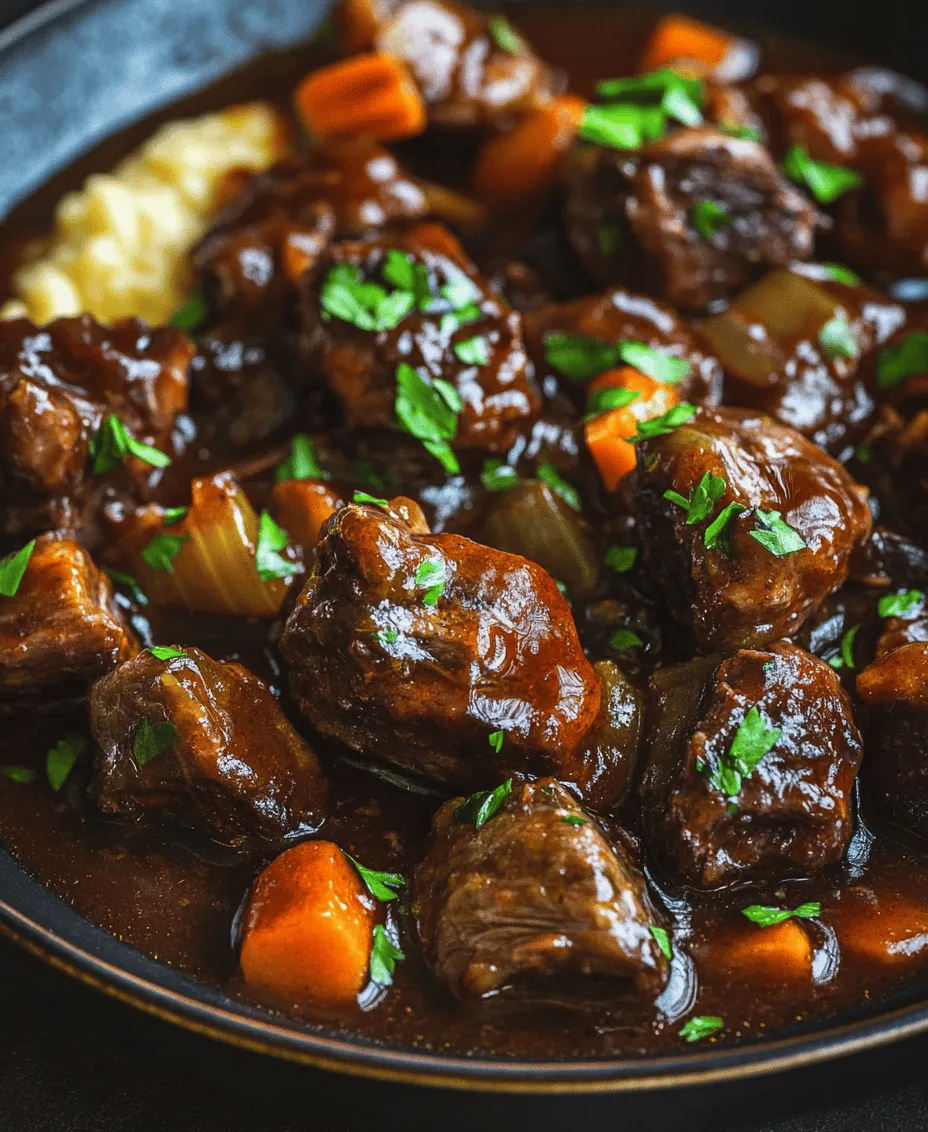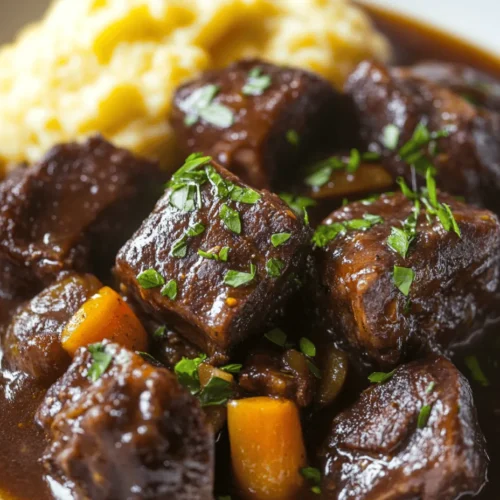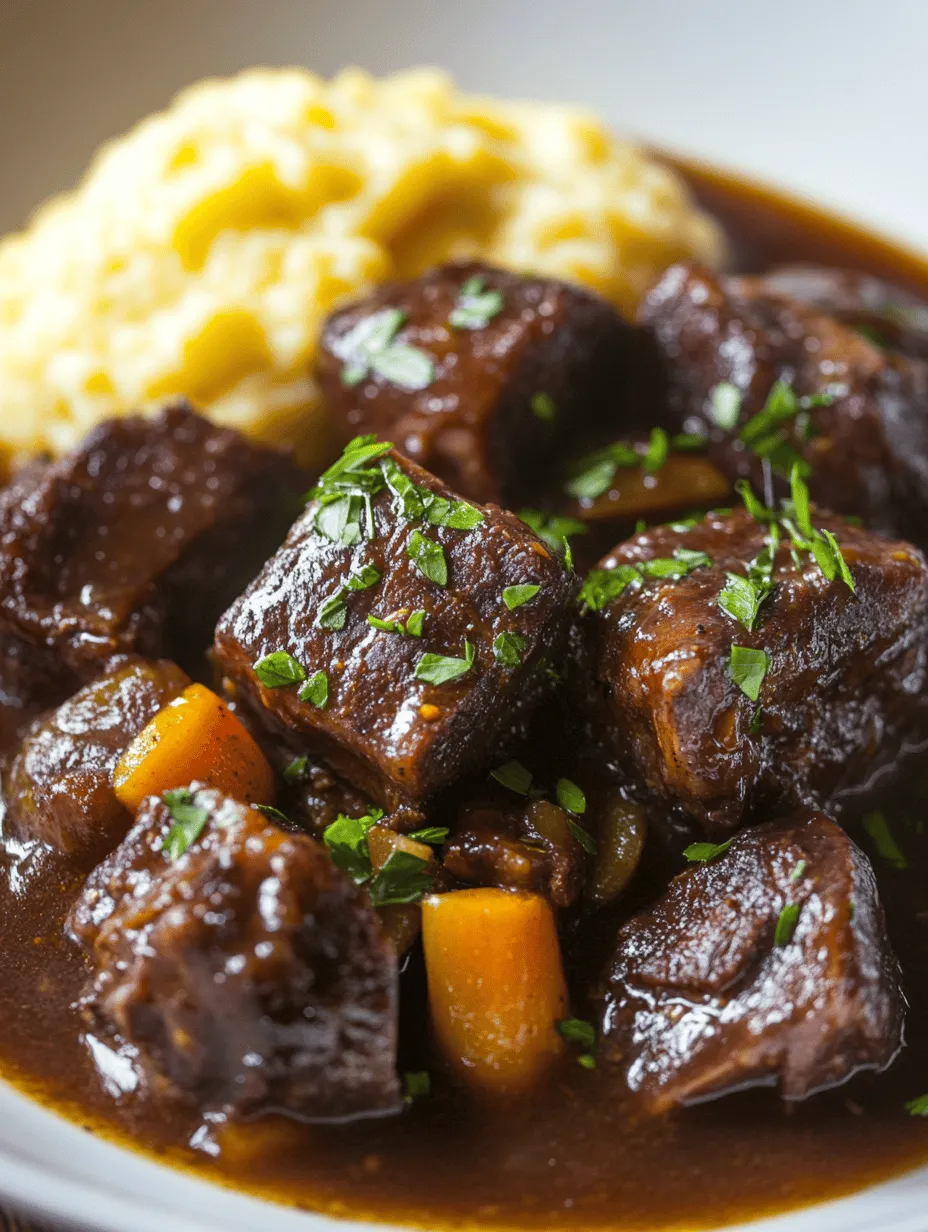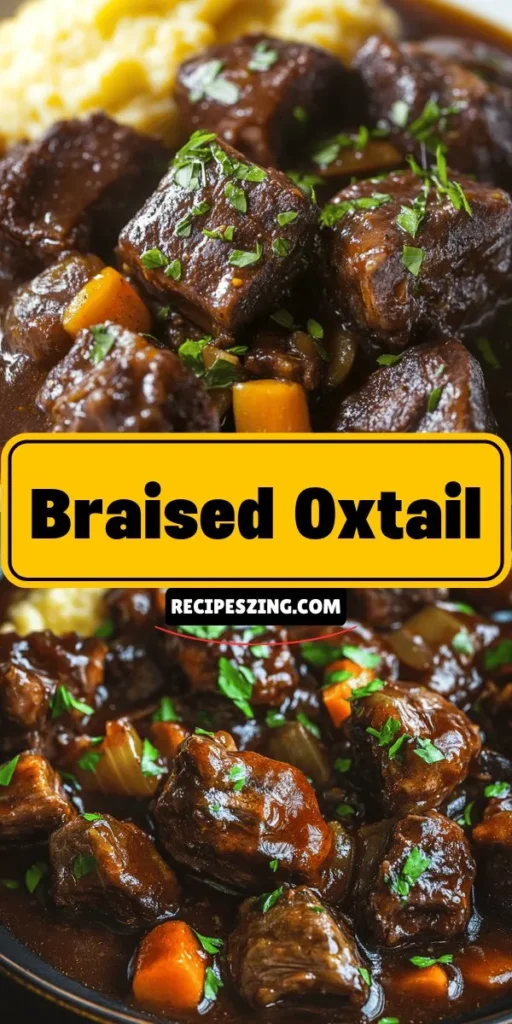Introduction
Welcome to the world of braised oxtail, a dish that promises to envelop you in warmth and comfort with every bite. Fall-Off-The-Bone Braised Oxtail Delight is not just a meal; it’s an experience steeped in rich flavors and textures that can elevate any dining occasion. This traditional dish has roots in various global cuisines, celebrated for its deep, soulful tastes and melt-in-your-mouth tenderness. As we delve into this recipe, you’ll discover the essential techniques and ingredients that come together to create this culinary masterpiece.
Oxtail, once considered a humble cut of meat, has transformed into a sought-after delicacy that captivates food enthusiasts and home cooks alike. The beauty of braising lies in its ability to transform tougher cuts of meat into succulent, tender dishes that are bursting with flavor. Whether you’re planning a dinner party or simply craving a hearty meal for yourself, this braised oxtail recipe stands out as a must-try.
In this article, we will take you through the journey of preparing this delightful dish, from understanding the unique characteristics of oxtail to the step-by-step process that will ensure your success in the kitchen. Let’s embark on this flavorful adventure together!
Understanding Oxtail: A Culinary Gem
Exploring the Origins of Oxtail
Oxtail, as the name suggests, refers to the tail of cattle. Historically, this cut of meat has been cherished in various cultures around the world. Its significance can be traced back to times when resourcefulness in cooking was paramount, leading to the use of every part of the animal. In many cuisines, oxtail has been a staple in hearty stews and broths, showcasing its versatility and rich flavor profile.
With roots in French, Italian, and Jamaican cooking, each culture has its own interpretation of this dish. In the French culinary tradition, oxtail is often featured in rich, wine-based stews, while in Jamaican cuisine, it’s typically cooked in a spicy sauce with vegetables, reflecting the country’s vibrant culinary heritage. Regardless of the preparation style, the unifying element remains the oxtail’s ability to absorb flavors and develop a luscious texture when cooked properly.
Beyond its cultural relevance, oxtail also offers a wealth of nutritional benefits. Rich in collagen, oxtail provides essential amino acids, making it a source of protein that supports joint health and skin elasticity. The slow cooking process also allows for the extraction of vitamins and minerals, resulting in a nourishing dish that can be enjoyed by all.
Why Choose Braising?
When it comes to cooking oxtail, braising is the method of choice for many chefs and home cooks. This cooking technique involves searing the meat to create a savory crust followed by slow cooking in a flavorful liquid. The science behind braising is rooted in its ability to break down tough connective tissues, transforming the meat into a tender delight.
Braising is not only a flavorful cooking method but also an incredibly forgiving one. The low and slow approach allows for mistakes to be corrected, making it ideal for less experienced cooks. The extended cooking time ensures that the flavors meld together beautifully, resulting in a dish that bursts with depth and complexity.
One of the key benefits of braising is how it enhances flavor development. The combination of browning the meat and simmering it in a liquid—typically a combination of broth and wine—creates a rich, aromatic sauce that complements the oxtail perfectly. This slow-cooking method allows the meat to absorb the flavors of the aromatics, herbs, and spices, resulting in an unforgettable dining experience.
Ingredients Breakdown: The Essentials for Success
Key Components of the Recipe
To achieve the ultimate Fall-Off-The-Bone Braised Oxtail Delight, selecting the right ingredients is crucial. Here’s an overview of what you’ll need to create this exquisite dish:
– Oxtail: The star of the show, oxtail should be fresh and meaty. Look for pieces with a good amount of meat and marrow, as these will render the best flavor during cooking.
– Red Wine: A good-quality dry red wine adds depth and richness to the braising liquid. Choose a wine you would enjoy drinking, as its flavors will concentrate during the cooking process.
– Beef Broth: Homemade or store-bought beef broth provides a savory base for the braise. Opt for low-sodium broth to control the seasoning levels.
– Aromatics: Onions, garlic, and carrots are traditional aromatics that enhance the flavor profile of the dish. They contribute sweetness and depth, balancing the richness of the oxtail.
– Herbs and Spices: Fresh thyme, bay leaves, and black peppercorns are essential for infusing the dish with flavor. These elements work together to create a harmonious blend that elevates the oxtail.
A Closer Look at Seasonings and Aromatics
The impact of seasonings and aromatics on the flavor profile of your braised oxtail cannot be overstated. Fresh herbs, such as thyme and parsley, not only add vibrant flavor but also bring a touch of freshness that cuts through the richness of the dish. Using whole spices like black peppercorns enhances the overall taste, providing a subtle heat that complements the dish beautifully.
Aromatics like onions and garlic serve as the foundation for your braising liquid. When sautéed, they release their natural sugars, caramelizing and developing a rich flavor that forms the base of your sauce. Carrots not only add sweetness but also contribute to the overall texture of the dish, as they soften and meld into the sauce during cooking.
Choosing high-quality ingredients is paramount to the success of this recipe. The flavor of your braised oxtail will reflect the quality of the wine and broth used. A robust red wine, such as a Cabernet Sauvignon or Merlot, will provide the best results, while a homemade beef broth will infuse the dish with unparalleled depth and richness.
Step-by-Step Cooking Instructions
Preparation: Setting the Stage for a Delicious Meal
Before diving into the cooking process, it’s essential to gather your tools and ingredients. Here’s what you’ll need:
– A large, heavy-bottomed pot or Dutch oven
– A sharp knife for cutting
– A cutting board
– A wooden spoon or spatula for stirring
– Measuring cups and spoons
Once you have your tools set up, it’s time to prepare the oxtail. Start by trimming any excess fat from the meat. While some fat is desirable for flavor, too much can lead to an overly greasy dish. Pat the oxtail dry with paper towels to ensure a good sear during cooking; moisture can prevent proper browning.
Searing the Oxtail: The Foundation of Flavor
Searing the oxtail is a crucial step that lays the groundwork for the rich flavor profile of your dish. Begin by heating your pot over medium-high heat and adding a splash of oil. Once the oil is shimmering, carefully place the oxtail pieces in the pot, ensuring not to overcrowd them. You may need to work in batches to achieve a proper sear.
Let the oxtail cook undisturbed for several minutes until a deep brown crust forms on one side. This caramelization is essential, as it adds complexity to the dish. Once browned, turn the oxtail to sear all sides, ensuring each piece is beautifully browned. Once the oxtail is seared to perfection, remove it from the pot and set it aside.
The fond left in the pot—those browned bits stuck to the bottom—is packed with flavor. Avoid cleaning the pot; instead, deglaze it with a splash of red wine. Use a wooden spoon to scrape up the fond, incorporating all those delicious flavors into your cooking liquid. This process not only enhances the taste of your braised oxtail but also adds a beautiful depth to the sauce that will develop during the cooking process.
With the oxtail seared and the pot deglazed, you are now ready to continue building the layers of flavor that will make this dish a true delight.

Sautéing the Aromatics: Building Layers of Taste
Creating a rich and flavorful braised oxtail begins with sautéing the aromatics. This foundational step is essential for developing deep, complex flavors that will enhance the entire dish.
Best Practices for Sautéing Vegetables
When sautéing vegetables like onions, carrots, and celery, it’s important to follow a few key practices:
1. Use the Right Fat: Choose a high smoke point oil, such as vegetable or canola oil, or opt for butter for a richer flavor. A combination of both can yield the best results.
2. Don’t Overcrowd the Pan: Ensure the vegetables have enough space to sauté evenly. If the pan is too crowded, the vegetables will steam rather than brown, leading to a less flavorful base.
3. Monitor the Heat: Start with medium heat to soften the vegetables gently. Once they’re translucent, you can increase the heat slightly to achieve a nice caramelization.
Timing and Techniques for Adding Garlic
Garlic is a powerful flavor enhancer but can turn bitter if overcooked. Here’s how to incorporate it effectively:
– Add It Last: Once the onions are translucent and the other aromatics are soft, add minced garlic to the pan. Sauté for only about 30 seconds until fragrant, stirring constantly to prevent burning.
– Use Fresh Garlic: For the best flavor, use fresh garlic rather than pre-minced or jarred varieties. Fresh garlic provides a vibrant taste that enhances the dish.
Deglazing: Unlocking Hidden Flavors
After sautéing the aromatics, the next step is deglazing the pot. This technique will help you capture all the flavorful bits stuck at the bottom of your pan, known as fond.
How to Properly Deglaze the Pot
1. Choose Your Liquid: While this recipe calls for red wine, you can also use broth or water if you prefer. The liquid should be added gradually to prevent splattering.
2. Scrape the Bottom: Pour the wine into the hot pan while scraping the bottom with a wooden spoon to release those delicious browned bits. This step is crucial for building a flavorful base for your braising liquid.
The Role of Red Wine in Flavor Enhancement
Red wine adds depth and richness to the dish. It not only deglazes the pan but also infuses the meat with its robust flavors.
– Select Quality Wine: Choose a dry red wine that’s good enough to drink. Varietals like Cabernet Sauvignon or Merlot work well in this recipe, contributing fruity and tannic notes that complement the oxtail beautifully.
– Let It Simmer: Allow the wine to simmer for a couple of minutes before adding the next ingredients. This helps to reduce the acidity and concentrate the flavors.
Creating the Braising Liquid: A Symphony of Ingredients
With your pot deglazed, it’s time to create the braising liquid. This mixture will envelop the oxtails during cooking, infusing them with flavor.
Balancing Flavors in the Braising Liquid
A well-balanced braising liquid is key to achieving a delicious final dish. Here’s how to create that perfect harmony:
1. Base Ingredients: Combine the deglazed wine with beef broth, which provides a savory backbone. You can use homemade or store-bought broth, but opt for low-sodium variations to control the saltiness.
2. Add Acidity: A splash of balsamic vinegar or a squeeze of lemon juice can brighten the dish and cut through the richness of the meat and sauce.
3. Herbs and Spices: Incorporate fresh herbs like thyme and bay leaves, as well as spices like black pepper and a pinch of red pepper flakes for warmth.
Adjusting Seasoning for Personal Taste Preferences
Taste your braising liquid before adding the oxtails. Adjust the seasoning by adding salt or additional herbs as needed. Remember, the flavors will concentrate as the liquid reduces during cooking, so it’s okay to start with a slightly lighter seasoning.
Braising Process: The Heart of the Recipe
Braising is a method that combines both dry and wet cooking techniques, allowing the meat to become tender and flavorful.
Importance of Temperature and Time in Braising
1. Temperature: Preheat your oven to a low temperature, typically between 300°F to 325°F (150°C to 160°C). This slow cooking process helps break down the connective tissues in the oxtail, resulting in incredibly tender meat.
2. Time: Braising will typically take about 2.5 to 3 hours. Check the oxtails periodically to ensure they’re not cooking too quickly.
Tips for Checking Tenderness and Doneness
– Visual Cues: The meat should be pulling away from the bone and look glossy when done.
– Fork Test: Use a fork to gently prod the meat. If it falls apart easily, it’s perfectly tender and ready to be removed from the oven.
Finishing Touches: Sauce Reduction and Presentation
Once your oxtails are braised to perfection, it’s time to finish the dish with a rich sauce and appealing presentation.
Techniques for Skimming Fat and Thickening Sauce
1. Skimming the Fat: After removing the oxtails from the pot, let the sauce sit for a few minutes. Fat will rise to the top, allowing you to skim off the excess for a cleaner sauce.
2. Thickening the Sauce: If the sauce is too thin, you can reduce it by simmering it uncovered on the stovetop until it thickens to your liking. Alternatively, whisk in a slurry made from cornstarch and water.
Plating Suggestions for a Visually Appealing Dish
– Choose the Right Plate: Use a wide, shallow bowl or a large plate to showcase the oxtail and sauce.
– Layering: Spoon a generous serving of the sauce onto the plate, then place the oxtail on top.
– Garnishing: Finish with fresh herbs like parsley or thyme for a pop of color and freshness.
Serving Suggestions: Complementing the Oxtail Delight
Ideal Pairings for Braised Oxtail
To create a well-rounded meal, consider complementary side dishes that harmonize with the rich flavors of braised oxtail:
– Creamy Polenta: Its smooth texture and subtle flavor provide a perfect backdrop for the robust oxtail.
– Mashed Potatoes: Buttery and fluffy mashed potatoes can soak up the delicious sauce, making each bite satisfying.
– Crusty Bread: A loaf of fresh, crusty bread is ideal for mopping up the flavorful sauce.
Wine Pairings That Enhance the Dining Experience
For an elevated dining experience, serve your oxtail delight with a glass of red wine.
– Full-Bodied Reds: Wines like Cabernet Sauvignon or Syrah will complement the dish’s richness and enhance its flavors.
– Lighter Varietals: If you prefer a lighter wine, consider a Pinot Noir, which offers a nice acidity that can cut through the richness of the oxtail.
Creative Serving Ideas
– Presentation Tips to Elevate Your Dish: Consider using a ring mold to shape the polenta or mashed potatoes for a refined look. Serve the oxtail on top for a stunning presentation.
– Garnishing with Fresh Herbs for Added Freshness: A sprinkle of freshly chopped herbs not only adds a beautiful contrast but also brings brightness to the dish.
Conclusion
In conclusion, the Fall-Off-The-Bone Braised Oxtail Delight is not just a meal; it’s an experience filled with rich flavors and comforting aromas. By following the detailed steps outlined in this article, you can bring this culinary masterpiece to your kitchen. This dish is ideal for gatherings and special occasions, showcasing the beauty of slow-cooked, hearty meals. Embrace the art of braising and enjoy the satisfaction that comes from creating a dish that is both delicious and memorable. Whether served at a cozy family dinner or a festive celebration, this braised oxtail will leave a lasting impression on your guests and create cherished culinary memories.



